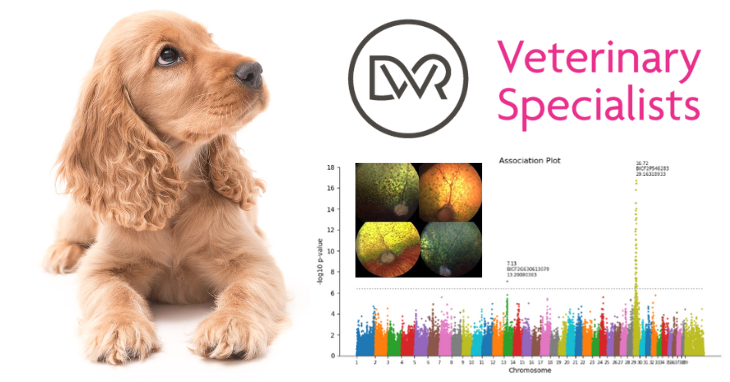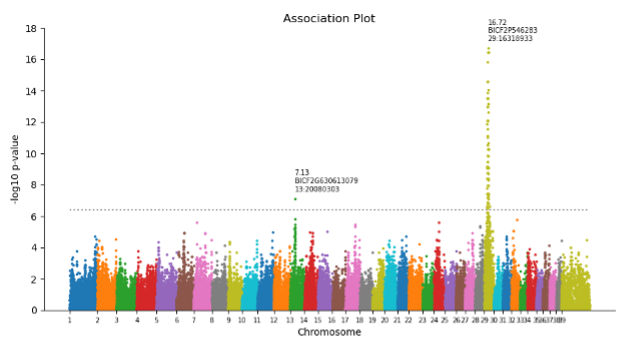
In collaboration with James Oliver, head of ophthalmology at Dick White Referrals, we have been researching retinopathy with vitamin E deficiency (RVED) in the English Cocker Spaniel (ECS) for a number of years. It has been a challenging project, so we are over the moon to report that we have identified the variant associated with the disease, and all of our findings have now been published in G3 Genes|Genomes|Genetics.
Oliver, J. A. C., Stanbury, K., Schofield, E., McLaughlin, B., & Mellersh, C. S. (2025). A TTPA deletion is associated with retinopathy with vitamin E deficiency in the English Cocker Spaniel dog. G3 Genes|Genomes|Genetics. https://doi.org/10.1093/g3journal/jkaf016
This research allowed for the creation of a DNA test for the variant, which CAGT launched in August of last year. This was a particularly exciting and rewarding DNA test launch, because it can identify pre-symptomatic dogs who can then receive early therapeutic intervention, in addition to dogs who carry the variant. The treatment is simple and can halt disease progression if clinical signs have already been observed, or prevent the disease entirely if detected early enough.
The disease is an inherited form of vitamin E deficiency, inheritance is recessive so a dog would need two copies of the variant to be clinically affected. When vitamin E is severely deficient in the body, pigment granules known as lipofuscin build up in multiple tissues in the body such as in muscle, brain, reproductive tract and in the eye. In the eye, the granules accumulate in the retina and are associated with retinal degeneration which if left untreated, leads to complete blindness. Some dogs also suffer from neurological problems such as ataxia and seizures. Until now, RVED could only be diagnosed by referral to a veterinary ophthalmologist and documentation of typical pigmented spots in the retina followed by a blood test to demonstrate low circulating blood vitamin E concentration.
The road to this discovery has been a long one and had a few bumps along the way. Back in 2022 we performed a Genome Wide Association Study (GWAS) comprising 20 RVED cases and 30 controls and the result was a “stonking peak” on chromosome 29.
But our initial elation was short lived, as all follow-on analyses failed to lead us to a convincing causal variant. The GWAS data was generated from co-ordinates derived from the canine reference genome CanFam3.1 which as it turns out, and to cut a long story short, is incorrectly annotated in the region where we finally found our variant. We whole genome sequenced two ECS RVED cases and aligned them to a newer and more comprehensively annotated canine reference genome, CanFam4, and pipeline analysis identified a variant in an excellent candidate gene. The gene is known as TTPA which encodes the alpha-tocopherol transfer protein. TTPA transports the most abundant, and biologically active form of Vitamin E, alpha-tocopherol, around the body and which is a vital anti-oxidant in a number of tissues. The variant itself is a 102bp deletion located in the first exon of the gene, the genetic sequence remains in frame but truncates the protein by 34 amino acids. The next hurdle was to create an assay that could genotype further cases to validate the variant. The region has an extremely high abundance of guanine and cytosine nucleotides which makes it a very tricky region to work within. But we didn’t give up and created an assay that enabled us to initially test 30 RVED-affected ECS and 43 controls (ECS certified clear of inherited eye disease over the age of 6). The variant segregated perfectly, with cases homozygous for the variant and controls either carriers or homozygous for the reference sequence. Further validation of the variant was carried out in 186 ECS randomly selected from our DNA archive (see a presentation about this invaluable resource here). This revealed an allele frequency of 0.11 which was comparable to the frequency of 0.09 observed in the initial control cohort. If we assume random segregation of this variant within the English Cocker Spaniel population, this would equate to around 210 Kennel Club registered dogs having 2 copies of the variant and thus affected with RVED each year. This number is likely to be a gross underestimate as only a minority of ECS are KC registered. So we believe that this research, carried out by the Canine Genetics Centre, in collaboration with James is of vital importance to the ECS breed.


